Papers by Jose-Luis Jaramillo
arXiv (Cornell University), Dec 22, 2011
We discuss an alternative way of prescribing the spacetime geometry associated with a nonradiatin... more We discuss an alternative way of prescribing the spacetime geometry associated with a nonradiating distribution of charged matter. It is based on the possibility that the electrostatic selfenergy does not reside on the Coulombian field but in a matter pressure term of electromagnetic origin localized at the sources. We work out completely the well controlled spherically symmetric case, questioning the realization of Reissner-Nordström geometry in nature. Finally, we sketch an experiment that could distinguish between the standard and the alternative scenario.
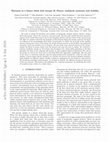
arXiv (Cornell University), Jun 6, 2020
We study in detail the dynamics and stability of marginally trapped surfaces during a binary blac... more We study in detail the dynamics and stability of marginally trapped surfaces during a binary black hole merger. This is the second in a two-part study. The first part studied the basic geometric aspects of the world tubes traced out by the marginal surfaces and the status of the area increase law. Here we continue and study the dynamics of the horizons during the merger, again for the headon collision of two non-spinning black holes. In particular we follow the spectrum of the stability operator during the course of the merger for all the horizons present in the problem and implement systematic spectrum statistics for its analysis. We also study more physical aspects of the merger, namely the fluxes of energy which cross the horizon and cause the area to change. We construct a natural coordinate system on the horizon and decompose the various fields appearing in the flux, primarily the shear of the outgoing null normal, in spin weighted spherical harmonics. For each of the modes we extract the decay rates as the final black hole approaches equilibrium. The late part of the decay is consistent with the expected quasi-normal mode frequencies, while the early part displays a much steeper fall-off. Similarly, we calculate the decay of the horizon multipole moments, again finding two different regimes. Finally, seeking an explanation for this behavior, motivated by the membrane paradigm interpretation, we attempt to identify the different dynamical timescales of the area increase. This leads to the definition of a "slowness parameter" for predicting the onset of transition from a faster to a slower decay.

arXiv (Cornell University), Jun 6, 2020
Recent advances in numerical relativity have revealed how marginally trapped surfaces behave when... more Recent advances in numerical relativity have revealed how marginally trapped surfaces behave when black holes merge. It is now known that interesting topological features emerge during the merger, and marginally trapped surfaces can have self-intersections. This paper presents the most detailed study yet of the physical and geometric aspects of this scenario. For the case of a head-on collision of non-spinning black holes, we study in detail the world tube formed by the evolution of marginally trapped surfaces. In the first of this two-part study, we focus on geometrical properties of the dynamical horizons, i.e. the world tube traced out by the time evolution of marginally outer trapped surfaces. We show that even the simple case of a head-on collision of non-spinning black holes contains a rich variety of geometric and topological properties and is generally more complex than considered previously in the literature. The dynamical horizons are shown to have mixed signature and are not future marginally trapped everywhere. We analyze the area increase of the marginal surfaces along a sequence which connects the two initially disjoint horizons with the final common horizon. While the area does increase overall along this sequence, it is not monotonic. We find short durations of anomalous area change which, given the connection of area with entropy, might have interesting physical consequences. We investigate the possible reasons for this effect and show that it is consistent with existing proofs of the area increase law.
The Ninth Marcel Grossmann Meeting, 2002
ABSTRACT We introduce matter degrees of freedom into a recently proposed 2D quantum gravity model... more ABSTRACT We introduce matter degrees of freedom into a recently proposed 2D quantum gravity model based on the Virasoro group. Quantum diffeomorphisms have dynamical content in this model, thus spoiling their classical gauge nature. The algebra of observables is enlarged now with the inclusion of an ensemble of new operators closing the affine Kac-Moody algebra of the (non-compact) semi-simple group SL(2, R), and constituting the modes of a set of scalar fields. The gravity effect on those new fields is accomplished by the natural semi-direct action of the Virasoro group on the new subalgebra. While the model is rather entangled at the severe quantum regime, at the semi-classical level we recover the action of the scalar fields modified with an added gravitational interaction term...
AIP Conference Proceedings, 2006
... a geometrical approach José Luis Jaramillo Laboratoire de l'Univers et de ses Théories (... more ... a geometrical approach José Luis Jaramillo Laboratoire de l'Univers et de ses Théories (LUTH) Observatoire de Paris Meudon, France In collaboration with Silvano Bonazzola, FrançoisLimousin, Eric Gourgoulhon and Sergio Dain, Badri Krishnan Page 2. 1 ...
EAS Publications Series, 2008
Our current picture of black hole gravitational collapse relies on two assumptions: i) the result... more Our current picture of black hole gravitational collapse relies on two assumptions: i) the resulting singularity is hidden behind an event horizon-weak cosmic censorship conjecture-and ii) spacetime eventually settles down to a stationarity state. In this setting, it follows that the minimal area containing an apparent horizon is bound by the square of the total ADM mass (Penrose inequality conjecture). Following Dain et al. 2002, we construct numerically a family of axisymmetric initial data with one or several marginally trapped surfaces. Penrose and related geometric inequalities are discused for these data. As a by-product, it is shown how Penrose inequality can be used as a diagnosis for an apparent horizon finder numerical routine.
The Twelfth Marcel Grossmann Meeting - On Recent Developments in Theoretical and Experimental General Relativity Astrophysics and Relativistic Field Theories - Proceedings of the MG12 Meeting on General Relativity, 2012
Using a constrained formalism for Einstein equations in Dirac gauge, we propose to compute excise... more Using a constrained formalism for Einstein equations in Dirac gauge, we propose to compute excised quasistationary initial data for black hole spacetimes in full general relativity. Vacuum spacetime settings are numerically constructed by using the isolated horizon formalism; we especially tackle the conformal metric part of our equations, assuming global stationarity. We show that a no-boundary treatment can be used on the horizon for the equation related to the conformal metric. We relate this finding to previous suggestions in the literature, and use our results to assess the widely used conformally flat approximation for computing black hole initial data.
The minimal coupling principle is revisited in a group-cohomological setting. Promoting space-tim... more The minimal coupling principle is revisited in a group-cohomological setting. Promoting space-time translations to a "local" symmetry of the Lagrangian of the free particle once the "kinematical" symmetry group (either Galilei or Poincaré) has been centrally extended by U (1) results in a new electromagnetic force of pure gravitational origin. This constitutes a preliminary attempt to a non-trivial mixing of space-time and internal gauge symmetries and/or interactions. 1 Work partially supported by the DGICYT.
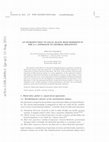
International Journal of Modern Physics: Conference Series, 2012
We present an introduction to dynamical trapping horizons as quasi-local models for black hole ho... more We present an introduction to dynamical trapping horizons as quasi-local models for black hole horizons, from the perspective of an Initial Value Problem approach to the construction of generic black hole spacetimes. We focus on the geometric and structural properties of these horizons aiming, as a main application, at the numerical evolution and analysis of black hole spacetimes in astrophysical scenarios. In this setting, we discuss their dual role as an a priori ingredient in certain formulations of Einstein equations and as an a posteriori tool for the diagnosis of dynamical black hole spacetimes. Complementary to the first-principles discussion of quasi-local horizon physics, we place an emphasis on the rigidity properties of these hypersurfaces and their role as privileged geometric probes into near-horizon strong-field spacetime dynamics.
Physical Review D, 2012
We show that the area-angular momentum-charge inequality (A/(4π)) 2 ≥ (2J) 2 + (Q 2 E + Q 2 M) 2 ... more We show that the area-angular momentum-charge inequality (A/(4π)) 2 ≥ (2J) 2 + (Q 2 E + Q 2 M) 2 holds for apparent horizons of electrically and magnetically charged rotating black holes in generic dynamical and nonvacuum spacetimes. More specifically, this quasi-local inequality applies to axially symmetric closed outermost stably marginally (outer) trapped surfaces, embedded in non-necessarily axisymmetric black hole spacetimes with non-negative cosmological constant and matter content satisfying the dominant energy condition.
Physical Review D, 2004
We present a set of boundary conditions for solving the elliptic equations in the Initial Data Pr... more We present a set of boundary conditions for solving the elliptic equations in the Initial Data Problem for space-times containing a black hole, together with a number of constraints to be satisfied by the otherwise freely specifiable standard parameters of the Conformal Thin Sandwich formulation. These conditions altogether are sufficient for the construction of a horizon that is instantaneously in equilibrium in the sense of the Isolated Horizons formalism. We then investigate the application of these conditions to the Initial Data Problem of binary black holes and discuss the relation of our analysis with other proposals that exist in the literature.
Mass and Motion in General Relativity, 2009
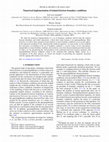
Physical Review D, 2007
We study the numerical implementation of a set of boundary conditions derived from the isolated h... more We study the numerical implementation of a set of boundary conditions derived from the isolated horizon formalism, and which characterize a black hole whose horizon is in quasiequilibrium. More precisely, we enforce these geometrical prescriptions as inner boundary conditions on an excised sphere, in the numerical resolution of the conformal thin sandwich equations. As main results, we first establish the consistency of including in the set of boundary conditions a constant surface gravity prescription, interpretable as a lapse boundary condition, and second we assess how the prescriptions presented recently by Dain et al. for guaranteeing the well-posedness of the conformal transverse traceless equations with quasiequilibrium horizon conditions extend to the conformal thin sandwich elliptic system. As a consequence of the latter analysis, we discuss the freedom of prescribing the expansion associated with the ingoing null normal at the horizon.
Physical Review D, 2005
We present a general construction of initial data for Einstein's equations containing an arbitrar... more We present a general construction of initial data for Einstein's equations containing an arbitrary number of black holes, each of which is instantaneously in equilibrium. Each black hole is taken to be a marginally trapped surface and plays the role of the inner boundary of the Cauchy surface. The black hole is taken to be instantaneously isolated if its outgoing null rays are shear-free. Starting from the choice of a conformal metric and the freely specifiable part of the extrinsic curvature in the bulk, we give a prescription for choosing the shape of the inner boundaries and the boundary conditions that must be imposed there. We show rigorously that with these choices, the resulting non-linear elliptic system always admits solutions.
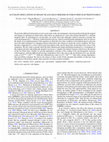
The Astrophysical Journal, 2012
We provide additional information on our recent study of the electromagnetic emission produced du... more We provide additional information on our recent study of the electromagnetic emission produced during the inspiral and merger of supermassive black holes when these are immersed in a force-free plasma threaded by a uniform magnetic field. As anticipated in a recent letter, our results show that although a dual-jet structure is present, the associated luminosity is ∼100 times smaller than the total one, which is predominantly quadrupolar. Here we discuss the details of our implementation of the equations in which the force-free condition is not implemented at a discrete level, but rather obtained via a damping scheme which drives the solution to satisfy the correct condition. We show that this is important for a correct and accurate description of the current sheets that can develop in the course of the simulation. We also study in greater detail the three-dimensional charge distribution produced as a consequence of the inspiral and show that during the inspiral it possesses a complex but ordered structure which traces the motion of the two black holes. Finally, we provide quantitative estimates of the scaling of the electromagnetic emission with frequency, with the diffused part having a dependence that is the same as the gravitational-wave one and that scales as L non-coll EM ≈ Ω 10/3−8/3 , while the collimated one scales as L coll EM ≈ Ω 5/3−6/3 , thus with a steeper dependence than previously estimated. We discuss the impact of these results on the potential detectability of dual jets from supermassive black holes and the steps necessary for more accurate estimates.

Physics Reports, 2006
The isolated horizon formalism recently introduced by Ashtekar et al. aims at providing a quasi-l... more The isolated horizon formalism recently introduced by Ashtekar et al. aims at providing a quasi-local concept of a black hole in equilibrium in an otherwise possibly dynamical spacetime. In this formalism, a hierarchy of geometrical structures is constructed on a null hypersurface. On the other side, the 3+1 formulation of general relativity provides a powerful setting for studying the spacetime dynamics, in particular gravitational radiation from black hole systems. Here we revisit the kinematics and dynamics of null hypersurfaces by making use of some 3+1 slicing of spacetime. In particular, the additional structures induced on null hypersurfaces by the 3+1 slicing permit a natural extension to the full spacetime of geometrical quantities defined on the null hypersurface. This 4-dimensional point of view facilitates the link between the null and spatial geometries. We proceed by reformulating the isolated horizon structure in this framework. We also reformulate previous works, such as Damour's black hole mechanics, and make the link with a previous 3+1 approach of black hole horizon, namely the membrane paradigm. We explicit all geometrical objects in terms of 3+1 quantities, putting a special emphasis on the conformal 3+1 formulation. This is in particular relevant for the initial data problem of black hole spacetimes for numerical relativity. Illustrative examples are provided by considering various slicings of Schwarzschild and Kerr spacetimes.

Physical Review Letters, 2010
The generation of a large recoil velocity from the inspiral and merger of binary black holes repr... more The generation of a large recoil velocity from the inspiral and merger of binary black holes represents one of the most exciting results of numerical-relativity calculations. While many aspects of this process have been investigated and explained, the "antikick", namely the sudden deceleration after the merger, has not yet found a simple explanation. We show that the antikick can be understood in terms of the radiation from a deformed black hole where the anisotropic curvature distribution on the horizon correlates with the direction and intensity of the recoil. Our analysis is focussed on Robinson-Trautman spacetimes and allows us to measure both the energies and momenta radiated in a gauge-invariant manner. At the same time, this simpler setup provides the qualitative and quantitative features of merging black holes, opening the way to a deeper understanding of the nonlinear dynamics of black-hole spacetimes.
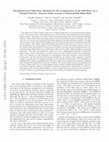
Physical Review D, 2010
The inspiral of a stellar compact object into a massive black hole, an extreme-mass-ratio inspira... more The inspiral of a stellar compact object into a massive black hole, an extreme-mass-ratio inspiral, is one of the main sources of gravitational waves for the future space-based Laser Interferometer Space Antenna. We expect to be able to detect and analyze many cycles of these slowly inspiraling systems, which makes them truly high precision tools for gravitational-wave astronomy. To that end, the use of very precise theoretical waveform templates in the data analysis is required. To build them we need to have a deep understanding of the gravitational backreaction mechanism responsible for the inspiral. The self-force approach describes the inspiral as the action of a local force that can be obtained from the regularization of the perturbations created by the stellar compact object on the massive black hole geometry. In this paper we extend a new time-domain technique for the computation of the self-force from the circular case to the case of eccentric orbits around a non-rotating black hole. The main idea behind our scheme is to use a multidomain framework in which the small compact object, described as a particle, is located at the interface between two subdomains. Then, the equations at each subdomain are homogeneous wave-type equations, without distributional sources. In this particle-without-particle formulation, the solution of the equations is smooth enough to provide good convergence properties for the numerical computations. This formulation is implemented by using a pseudospectral collocation method for the spatial discretization, combined with a Runge Kutta algorithm for the time evolution. We present results from several simulations of eccentric orbits in the case of a scalar charged particle around a Schwarzschild black hole, an excellent testbed model for testing the techniques for self-force computations. In particular, we show the convergence of the method and its ability to resolve the field and its derivatives across the particle location. Finally, we provide numerical values of the self-force for different orbital parameters.

Physical Review D, 2009
We present a numerical work aiming at the computation of excised initial data for black hole spac... more We present a numerical work aiming at the computation of excised initial data for black hole spacetimes in full general relativity, using Dirac gauge in the context of a constrained formalism for the Einstein equations. Introducing the isolated horizon formalism for black hole excision, we especially solve the conformal metric part of the equations, and assess the boundary condition problem for it. In the stationary single black hole case, we present and justify a no-boundary treatment on the black hole horizon. We compare the data obtained with the well-known analytic Kerr solution in Kerr-Schild coordinates, and assess the widely used conformally flat approximation for simulating axisymmetric black hole spacetimes. Our method shows good concordance on physical and geometrical issues, with the particular application of the isolated horizon multipolar analysis to confirm that the solution obtained is indeed the Kerr spacetime. Finally, we discuss a previous suggestion in the literature for the boundary conditions for the conformal geometry on the horizon.











Uploads
Papers by Jose-Luis Jaramillo